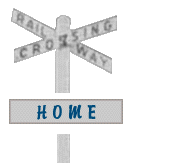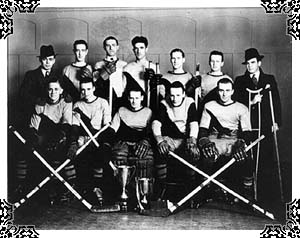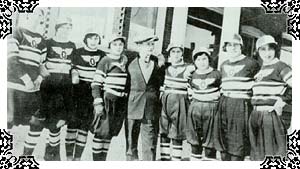








Hockey is almost a religion in Kensington, and during the winter months, possesses a powerful hold over the hearts and minds of the town. The sport has been played in almost every conceivable venue-- from rutted outdoor ponds to covered indoor rinks-- and has involved every part of the population-- from grandparents to children barely able to walk. Whether playing or watching the game, Kensington residents have approached the game less as pastime and more as a passion.
But the first indoor rink, the Community Gardens
built in 1929, was not at first a family affair. Men were
the only ones to allowed to use the ice, and their
children had to imitate their fathers the next day out on
frozen ponds in the vicinity. But whether the game
was played in the rink or on the ponds, the protective
equipment itself was equally makeshift. The only goalie
pads available were usually just two pieces of cardboard,
or even a thick Eaton's catalogue ripped in half, with
each half lashed over a shin. Despite the lack of
equipment, injuries were not common in the 1930s,
although there are accounts of one local player rubbing
his bumps with 'Absorbine'-- a horse liniment-- prior to
game time. One of the reasons that the pucks did not
bruise more shin bones was that players were not always
using the official hard rubber disk. As pucks were hard
to come by, and easily lost in snowbanks, sometimes the
heel of an old shoe would be pressed into service
instead, or if worse came to worse, there was always
plenty of frozen horse pies on a nearby sled track. The
goalie must have hoped the temperature stayed below
freezing!
In the 1930's, the standard store-bought hockey sticks sold for forty-five cents, and the top-flight model-- the "Swiper"-- went for ten cents extra because it was a single-piece without splices. But, while local boys would have done anything to boost their goal production, even the forty-five cent model was often beyond their means. Oftentimes, the search for a new stick meant taking to the woods to find a branch with a suitably-shaped curve to it, or nailing a slab of wood to an old broom.
 Skates
went through many different transformations over the
years. The earliest models, the 'stock skates,' were
usually home-made by a family member who knew something
about blacksmithing. The 'stock' skate was like a
foot-long sleigh runner strapped to the bottom of an
everyday boot, and secured by a long screw which extended
up into the heel. 'Spring' skates came next, a metal
frame which was attached to the boot by winding a key.
The 'automobile' skate-- a
Skates
went through many different transformations over the
years. The earliest models, the 'stock skates,' were
usually home-made by a family member who knew something
about blacksmithing. The 'stock' skate was like a
foot-long sleigh runner strapped to the bottom of an
everyday boot, and secured by a long screw which extended
up into the heel. 'Spring' skates came next, a metal
frame which was attached to the boot by winding a key.
The 'automobile' skate-- a  trademark of the CCM
company-- was the first version which resembled the
modern skate, with a complete boot and blade design that
at the time cost about $3.75. Sometimes a whole family
would have to share the same pairs of skates, with
younger members donning multiple pairs of wool socks to
take up the excess space. Despite the discomfort these
early skates sometimes caused, children wanted to spend
every spare moment out on the outdoor rinks. Parents
would even hide all the skates on Saturday night to
ensure that no one broke the Sabbath with a forbidden
game of shinny.
trademark of the CCM
company-- was the first version which resembled the
modern skate, with a complete boot and blade design that
at the time cost about $3.75. Sometimes a whole family
would have to share the same pairs of skates, with
younger members donning multiple pairs of wool socks to
take up the excess space. Despite the discomfort these
early skates sometimes caused, children wanted to spend
every spare moment out on the outdoor rinks. Parents
would even hide all the skates on Saturday night to
ensure that no one broke the Sabbath with a forbidden
game of shinny.
An important game at the Community Gardens was almost guaranteed to pack the rink to the rafters. When archrivals like Alberton or Borden hit the ice, extra trains would have to be scheduled to transport the crowds into town. The stands were strictly standing-room only, and up to 1200 fans could be crushed in shoulder to shoulder around the boards. This boisterous crowd must have been intimidating not only for visiting teams, but also for the referee, whose every decision was subject to intense scrutiny. When over a thousand irate voices began raining down on the referee, singing "We got the rope/ We got the tree/ All we need/ Is the referee!," it was hard to believe they were not serious.
 Along with their home
games, Kensington teams themselves played in other
communities across Prince County. However, getting to a
road game was frequently more of a battle than the match
itself, as reaching the rink often involved taking
different combinations of trains and horse-drawn sleighs.
In the 1930s, a local team ventured out to Victoria by
sleigh when it was 26 below, and on the trip back home,
became lost in a snowstorm for the night. In those days,
the phrase 'home rink advantage' really meant something!
Along with their home
games, Kensington teams themselves played in other
communities across Prince County. However, getting to a
road game was frequently more of a battle than the match
itself, as reaching the rink often involved taking
different combinations of trains and horse-drawn sleighs.
In the 1930s, a local team ventured out to Victoria by
sleigh when it was 26 below, and on the trip back home,
became lost in a snowstorm for the night. In those days,
the phrase 'home rink advantage' really meant something!
The earliest organized team to play out of the Community Gardens were the Granites, formed in the same year as the rink opened. The Granites played Senior 'A' hockey and, in a roundabout fashion, could even be considered semi-professional. While they were not paid to play, the players had much of their equipment supplied, and were given days off from their regular jobs so that they could prepare and travel to games. Besides, the players were looked upon as local heroes by the entire town. When a talented player from another area was spotted, the Granites would try to attract him to Kensington by finding him a job and a place to board. It is not unheard of, either, that players were talked into coming after partaking in a 'sip' or two.
The Granites wore a red shirt trimmed with
white, and the crest was a set of white wings framing a
flying 'G.' The nicknames of players on the team over the
years were as colorful as their uniforms. There was
"Stonewall" White, named for his stingy
goaltending; George "Porridge" Webster, named
after the famous nursery rhyme; and Elmer
"Chick" Bernard, who way back in elementary
school, had accidentally spelled 'chicken' instead of
'kitchen' in a spelling bee. In 1928, a group of
Kensington girls formed a team which was called the
Granite  Sisters.
They wore the same red and white colors as the Granites,
but also sported a peaked cap and-- at least at first--
navy blue bloomers. The men's Granites continue to hit
the ice every winter, and women's hockey has never been
more popular. All in all, Kensington's passion for the
national game shows no signs of cooling off any time
soon.
Sisters.
They wore the same red and white colors as the Granites,
but also sported a peaked cap and-- at least at first--
navy blue bloomers. The men's Granites continue to hit
the ice every winter, and women's hockey has never been
more popular. All in all, Kensington's passion for the
national game shows no signs of cooling off any time
soon.
Rinks | Horse Racing | Semple family | 'Big Jim' Pendergast | Recreation
